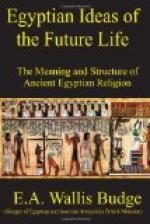We have seen that the entity of a man consisted of body, double, soul, heart, spiritual intelligence or spirit, power, shadow, and name. These eight parts may be reduced to three by leaving out of consideration the double, heart, power, shadow and name as representing beliefs which were produced by the Egyptian as he was slowly ascending the scale of civilization, and as being the peculiar product of his race; we may then say that a man consisted of body, soul, and spirit. But did all three rise, and live in the world beyond the grave? The Egyptian texts answer this question definitely; the soul and the spirit of the righteous passed from the body and lived with the beatified and the gods in heaven; but the physical body did not rise again, and it was believed never to leave the tomb. There were ignorant people in Egypt who, no doubt, believed in the resurrection of the corruptible body, and who imagined that the new life would be, after all, something very much like a continuation of that which they were living in this world; but the Egyptian who followed the teaching of his sacred writings knew that such beliefs were not consistent with the views of their priests and of educated people in general. Already in the Vth dynasty, about B.C. 3400, it is stated definitely:—
“The soul to heaven, the body to earth;” [Footnote: Recueil de Travaux, tom. iv. p. 71 (l. 582).] and three thousand years later the Egyptian writer declared the same thing, but in different words, when he wrote:—[Footnote: Horrack, Lamentations d’ Isis, Paris, 1866, p. 6.] “Heaven hath thy soul, and earth thy body.”
The Egyptian hoped, among other things, that he would sail over the sky in the boat of R[=a], but he knew well that he could not do this in his mortal body; he believed firmly that he would live for millions of years, but with the experience of the human race before him he knew that this also was impossible if the body in which he was to live was that in which he had lived upon earth. At first he thought that his physical body might, after the manner of the sun, be “renewed daily,” and that his new life would resemble that of that emblem of the Sun-god R[=a] with which he sought to identify himself. Later, however, his experience taught him that the best mummified body was sometimes destroyed, either by damp, or dry rot, or decay in one form or another, and that mummification alone was not sufficient to ensure resurrection or the attainment of the future life; and, in brief, he discovered that by no human means could that which is corruptible by nature be made to become incorruptible, for the very animals in which the gods themselves were incarnate became sick and died in their appointed season. It is hard to say why the Egyptians continued to mummify the dead since there is good reason for knowing that they did not expect the physical body to rise again. It may be that they thought its preservation necessary for the welfare of the KA, or “double,” and for the development of a new body from it; also the continued custom may have been the result of intense conservatism. But whatever the reason, the Egyptian never ceased to take every possible precaution to preserve the dead body intact, had he sought for help in his trouble from another source.




